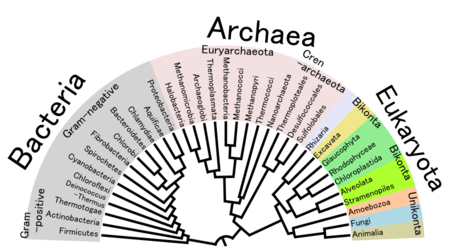The struggle for existence has pushed the plethora of life forms which inhabit Earth to colonise almost every niche available. Not only have organisms evolved to occupy and exploit relatively stable habitats such as oceans, forests and caves but have also evolved to inhabit the dynamic habitats that are other organisms. Vertebrates have the capacity to generate or retain heat, break down complex biological molecules into small easily manageable parts and maintain their inner environment - ideal requirements for a tiny invader to slip under the radar and infiltrate to shelter from the chaos of the outside world. This would be costly to the host organism, which’d lose nutrients and could be damaged, resulting in detriment to its survival – in short, it would get ill.

The phylogenetic tree of life
Life on Earth is divided into two domains - the prokaryotes and the eukaryotes. The prokaryotes are the bacteria and the archaea. The eukaryotes are everything else – animals (us!), plants, fungi and the protists. Prokaryotes came first, and the eukarotes diverged from prokaryotes about 1.5 billion years ago. Eukaryotes and prokaryotes have had a long time to diverge, and as such are vastly different types of cells. Their fundamental structure and biochemistry has major differences, and these differences allow multicellular eukaryotes like us to detect and deal with them. There really isn’t much risk of confusing a bacterial cell with our own cells so detecting them within the body isn’t as hard as it could potentially be. A very important point is that prokaryotic cells are dwarfed by eukaryotic cells. Viruses are even smaller than prokaryotes. Yeah… viruses are awkward - technically not living creatures, but biological entities all the same.

Size comparison of eukaryote, prokaryote and virus.
The dry mass of all cells is principally protein. Proteins perform the vast majority of biological functions and as such are present in abundance on the surface membrane of every cell in existence. So every single one of our own cells is coated in various proteins. The same goes for your parents, your dog, your dog’s fleas, your cat, the bacteria in your cats gut, your houseplant and the yeast that went into making your beer. Viruses are basically little protein capsules. And these proteins on the surface every cell gives that cell an identity. Other cells ‘read’ for specific proteins on other cells to determine if they’re friend or foe (using proteins on their own cell surfaces). Life is protein-tastic (someone had to say it).
Even single cellular organisms are at risk of intracellular invaders and have to have some kind of invader recognition and destruction mechanism. This will involve detection of foreign proteins. Multicellular organisms would have been giant fortresses in comparison to single cellular organisms, and would have (and still do) attract invaders to take advantage of their cellular processes. This evolutionary push for resources in ever more niche places forced selection of multicellular organisms with specialist systems to deal with invasion of foreign bodies – enter the immune system.
The immune system is divided into two parts; the innate immune system and the adaptive immune system. The innate immune system is a very primitive, general form of defence which includes chemical/physical barriers such as mucus, skin and stomach acid, as well as cellular/molecular defences such as inflammation, macrophages and the complement system. This is very non-specific and largely fixed. Macrophages are cells of the immune system which engulf and digest other cells and particles. The complement system is a defence against bacteria which involves the release of multiple protein subunits which embed in the bacterial cell wall, forming pores in the bacterial wall. This allows the unregulated flow of water (via osmosis) into the bacterium, causing it to burst (lysis). The innate immune system is the first line of defence against invaders, and begins its response as soon as the invader is detected.

Complement pore results in the unregulated influx of fluid, resulting in cell lysis
This innate system relies on detection via the use of basic cell surface receptors which recognise general protein structures (antigens) which are commonly found on invading entities. Multicellular organisms would have evolved these kinds of special cell surface receptors very early on in their evolution, possibly by adapting a pre-existing cell surface receptor.
The adaptive immune system is very much more complex, has molecular specificity to individual invaders, and can ‘learn’ to fight new invaders while retaining a molecular ‘memory’ of previous invaders to fight them off with increased efficiency should they have the nerve to try and invade again. The adaptive immune system relies on the complex interplay between B lymphocytes, T lymphocytes, macrophages, antigens and antibodies. The lymphocytes are the main cells of the adaptive immune system.
We have a pool of loads and loads of B lymphocytes, each expressing a different antibody on its surface. Each antibody is specific to a different antigen. When the antigen carrying invader comes into contact with its latent B lymphocyte (assuming its actually present in the pool of B lymphocytes to begin with), the antibody changes shape and initiates a cascade of cellular biochemical reactions within the B lymphocyte which cause that particular lymphocyte to proliferate into loads of plasma cells and memory cells. Plasma cells are a subtype of B lymphocyte which actively release their specific antibodies into the surrounding environment en masse to seek out and neutralise invaders. The memory cells are long lived cells which carry the surface version of the antibody which remain in the body to hold a ‘memory’ of this invader, to detect and initiate a fast response should the invader return. This is known as clonal selection.

The theory of clonal selection is how B cells are selected for their good antibodies in response to invasion.
This system is particularly good against bacteria, parasites and protein based toxins which exist outside of our cells, but what about those other harmful invaders – the viruses and cancer cells? Viruses enter our own cells and hijack them to turn them into virus-factories. Cancer cells don’t come in from outside, but rather our own cells going rogue and turning nasty. Viruses are semi-living molecules which are even tinier than bacteria. For these invasions from within, the major histocompatibility complex (MHC) comes into play. The MHC is a protein complex. The cell recognises foreign protein molecules within it due to their differing biochemistry, so chops them up with proteolytic enzymes. This generates lots of protein fragments which are bound to the MHC. The MHC takes these protein fragments and and presents them on the surface of the cell as a flag saying ‘I’M INFECTED/ROGUE, KILL ME BEFORE I INFECT THE OTHERS’. Killer T-cells detect this signal using proteins on their own surfaces, and proceed to kill the infected cell.

Killer T cell (also known as Cytotoxic T cell) kills aberrant host cells
Macrophages (of the innate immune system) use another type of MHC to facilitate the immune response. When they engulf a bacterium, they digest it to generate fragments to of bacterial protein. These are presented on their surface to inform local T cells of an invasion, and kick them into gear to go tell B cells to proliferate and release their important antibodies.
Antibodies are the other major players of adaptive immunity. Antibodies are highly specialised protein molecules. There are various types of antibody, each with a different role to play in defence against invasion. They can be bound to the surface of an immune cell, or released freely into the blood. Once free antibodies released by plasma cells bind to the invader, they have targeted that invader for destruction. Some antibody types will bind multiple invaders and cause them to clump together (known as agglutination) to make it easier for macrophages to come along and eat many of them at once. Others will attract various other cells of the immune system to come along and neutralise the threat. T lymphocytes are also involved in the adaptive immune response and do so by releasing factors which enhance the function of more active B lymphocytes, as well as differentiating into T Killer cells, which are particularly important in defence against virus infected cells and cancerous cells. Such cells that have turned cancerous, or harbour viruses give off cues which give away their abberant nature, and this is detected by surface-antibody presenting T killer cells which then actively kill the cell.
That’s a whistle-stop tour of how the immune system gets the job done. There’s a lot to it, and I couldn’t possibly cover every angle, but that’s the gist of how it works. But how does this work on the molecular level, and how did it evolve? Well, for the sake of not writing one single long-ass post (as if this isn’t long enough already), I’ll just put that in a subsequent post. I guess I just write these to the tune of my own attention span which probably isn’t representative of you guys - the great Tumblrverse, but the next post follows on from this and that explains some pretty interesting intricacies of immunology. At least I thought they were interesting, at any rate. So peace out! At least for the moment. Hmm, perhaps this is more of a ‘brb’ sign off. yeah - actually, that works better.

hunebe liked this
flymetouranus reblogged this from greatmindsofscience-blog
lotsnlotsoflove-blog reblogged this from thescienceofreality
heartoftardis reblogged this from thescienceofreality
shmaug-blog liked this
luzonite liked this
sub-sidera reblogged this from thescienceofreality
thescienceofreality reblogged this from captain-nitrogen-blog
sariemcstrickland liked this
 c0ldheartbb liked this
c0ldheartbb liked this flymetouranus liked this
greatmindsofscience-blog reblogged this from captain-nitrogen-blog
anthrojoyce reblogged this from captain-nitrogen-blog
thybiscuits liked this
apartment54 reblogged this from captain-nitrogen-blog
anthrojoyce liked this
pantsu liked this
neuroticthought liked this
fuguguru liked this
anandamideismystateofbliss liked this
karaniwangbinatilyo-blog liked this
thissideofeternity liked this
 bkamed-blog reblogged this from captain-nitrogen-blog
bkamed-blog reblogged this from captain-nitrogen-blog  lindsayslabyrinth-blog liked this
lindsayslabyrinth-blog liked this  ahugwouldbenice said:
Wow ! Best immulesson ever !
ahugwouldbenice said:
Wow ! Best immulesson ever ! misskariii liked this
 dontf-ckwiththepancreas reblogged this from captain-nitrogen-blog
dontf-ckwiththepancreas reblogged this from captain-nitrogen-blog  dontf-ckwiththepancreas liked this
dontf-ckwiththepancreas liked this smorgasbordofobsessions said: very interesting! thank you for writing all of this!
smorgasbordofobsessions liked this
kim-allen liked this
captain-nitrogen-blog posted this